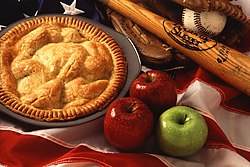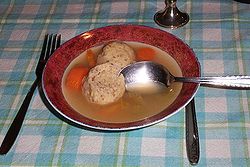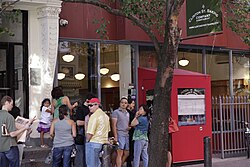Bodega food
Bodegas are convenience stores in New York City that stock a wide range of items, such as snacks, candies, and hot prepared food. [13] Bodegas can be found on nearly every corner; they provide items shoppers might have neglected to buy from a supermarket. [14] The word "bodega" originated from the Spanish word for small stores or groceries. Bodegas are important to their communities; customers trust them a location for safety and meeting with neighbors, and many have a resident cat. Some bodegas are open up to 24 hours, 7 days a week. [15]
Chopped cheese
The chopped cheese [16] is a sandwich that is one of the bodega's best-known menu items. This sandwich consists of chopped ground beef with onions, condiments melted cheese, tomatoes, and lettuce. It can either be served on a roll or a hero. [16] The chopped cheese has been mentioned in popular music, for example in rap lyrics. This sandwich is widely popular but there have been controversies, [16] such as issues with pricing and gentrification, but it remains a staple in New York City bodegas. Despite arguments about its origin, the chopped cheese sandwich is linked to Harlem and the Bronx. [17]
Bacon, egg and cheese
The bacon, egg and cheese sandwich (BEC) [18] is made with bacon, eggs that are either scrambled or fried, and cheese, and is served on a hero or a roll. This sandwich is common and well-known in New York City. This sandwich is a "morning sandwich"; it is known for being quickly prepared and for its affordability. Food critic Robert Sietsema has described the BEC as deli "haute cuisine." [19] Although many U.S. cities have similar sandwiches, the BEC stands out for its popularity and accessibility. [20]










